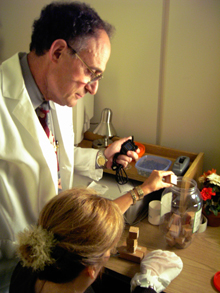Research
September 17, 2010
In stroke therapy, earlier is better

Steven Wolf is professor of rehabilitative medicine and principal investigator of the study.
Earlier is better for patients receiving a specific movement therapy for stroke, but those who delay therapy can still catch up, according to a comparison of two groups of patients published online in the journal Stroke.
The type of therapy, constraint-induced movement therapy (CIMT), involves restricting use of the less-impaired hand with a padded mitt for up to six hours a day, coupled with training in tasks such as opening a door, dressing or eating and drinking. The study enrolled 222 stroke patients who retained some ability to extend their arms and open their hands on the affected side.
The paper compared study participants who began a two-week course of CIMT three to nine months after their strokes to those who began therapy 15 to 21 months after stroke. The group that began CIMT sooner after their strokes saw greater improvement after a year, but the two groups were comparable after 24 months.
“If you delay therapy, you can get to the same place as the early therapy group, but it takes longer. The rate of improvement isn’t as fast,” says Steven Wolf, professor of rehabilitation medicine at the School of Medicine and principal investigator for the study, which involved several universities.
Participants were evaluated using the Wolf Motor Function Test, a measure of time needed to complete a task, as well as a Motor Activity Log tracking how well and how often 30 common daily activities were performed.
After two weeks of CIMT, early participants had their Motor Activity Log “amount of use” scores increase from 1.13 to 2.29, and end up at 2.17 a year later. Delayed participants had their scores increase from 1.79 to 2.45 after therapy and end up at 2.15.
Until a study known as EXCITE, research into CIMT for stroke rehabilitation had focused mostly on patients who had experienced a stroke more than a year ago. EXCITE was a study designed to demonstrate the efficacy of rehabilitative intervention.
“Our results illustrate the brain’s capacity to rewire itself,” Wolf says. “Even as fewer resources are available to address catastrophic injuries such as stroke, it’s important to know this group of patients still has a capacity to improve their ability to perform important functions when given the chance.”
The initial results of the EXCITE study were published in the Journal of the American Medical Association in 2006, and the trial was conducted in a crossover model. This means that study participants who acted as initial control subjects received CIMT after one year. Participants who delayed CIMT had other forms of treatment, such as massage, acupuncture or strength training while waiting — a potential complicating factor.
“We learned that it doesn’t matter what kind of treatment you get in the year before CIMT starts, because all the patients can respond to constraint therapy once it starts,” Wolf says.
